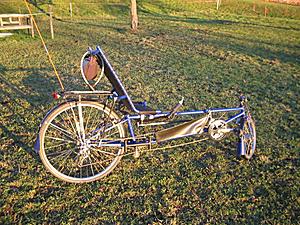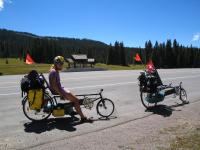

|
"Yes, we scan."
Barack Obama |
Fateba L1 Longrider
 , it's the old fashion longrider invented by Dave Wilson back in 1976, with some minor improvements. , it's the old fashion longrider invented by Dave Wilson back in 1976, with some minor improvements.
On The RoadMy ReviewI ride the longrider since 2003 with great enthusiasm and have done long tours of 7500km (4500 miles) and I'm very pleased and recommend it to tour travelers. Positive:
Negative:
Numbers
BrochureAn old version of the brochure:




Download Fateba Longrider Brochure (German version) (PDF) History of Fateba
 : :
Q: In an article that you wrote for RCN 62, you stated that Fomac had a patent on the Avatar design, but that within two years, many companies were building. Did you mean they were building Avatar look-alikes or recumbents? Was that a statement about the difficulty of protecting patents? A: It was there just for general information. But yes, I meant they were building Avatar look-alikes. It is tough for a small company to try to defend a patent. Also, when I saw the patent, I thought it was kind of vague (laughs). The look-alikes were the ones like Infinity and Linear, but it was the Europeans who really copied it, I mean piece for piece, like Radius and the Swiss Fateba. I approached Markus Hänni from Fateba Switzerland and he responded (01/2008): "We were approached by Andreas Naegeli (Velolaboratorium) in 1982 with the Avatar 2000 by Fomac Inc, and he offered us to use the Avatar 2000 for a certain time, because he didn't get so familiar with it himself.
Of course we studied the Avatar Patent thoroughly, but it didn't secure the concept of recumbent, but detail solutions like the seat attachment, seat position and steering bar attachment, etc. We looked also other alike recumbents like the first commercial taiwanese short rider "Funcycle", or the "Roulandt" from Netherlands, or the "Speedy" by Mike Burrows. Despite of all knowledge there were no solid cognitions on which we could have relied on, e.g. like on the diamond frame solution. So we had to build countless prototypes until we believed to have found the optimal pedal hub position and height, or the relation of seat height to pedal hub height. Whether under-seat steering (USS) or over-seat steering (OSS), how long the wheel base, there were thousands of open questions, not to mention the detail problems: how should be the seat? A tub like or a combination of ordinary saddle with back support, or a frame with a net? How to attach the seat to the frame, how to allow different body or leg lengths? To keep it short, we didn't copy the Avatar 2000 simply, but it's true without the Avatar 2000 there would be no Fateba recumbent."
When you look at the patent filed by Wilson and Forrestall and compare the two photos, it becomes obvious the Fateba is almost 100% copy of the Avatar 2000, the concept and design has been adapted entirely, yet many details have been improved which do not reveal themselves at the first sight, e.g. the steer bar is adjustable apart from the seat and thereby different arm length are supported. Fateba hasn't been willing or able to develop the longrider much further since 1990's, not even full suspension has been available yet which is standard for low- and shortriders. MaintenanceA friend of mine reminded me how important it is to keep a bicycle clean, not for fashion reason, but for extending the lifetime of a bicycle:
Since my recumbent is already over 10 years old, some parts started to rust, and I did sandpaper those parts, and painted with new colored varnish over, multiple layers. I have ridden the recumbent now for over 20,000 km, and it's, aside of a few dents in the varnish which are hardly recognizable, in a good shape also thanks to the maintenance. Later I like to extend the gear from 7 to 9 in order to extend the range of the gear transmission ratio, but this also implies a new back wheel altogether. Content:
|























